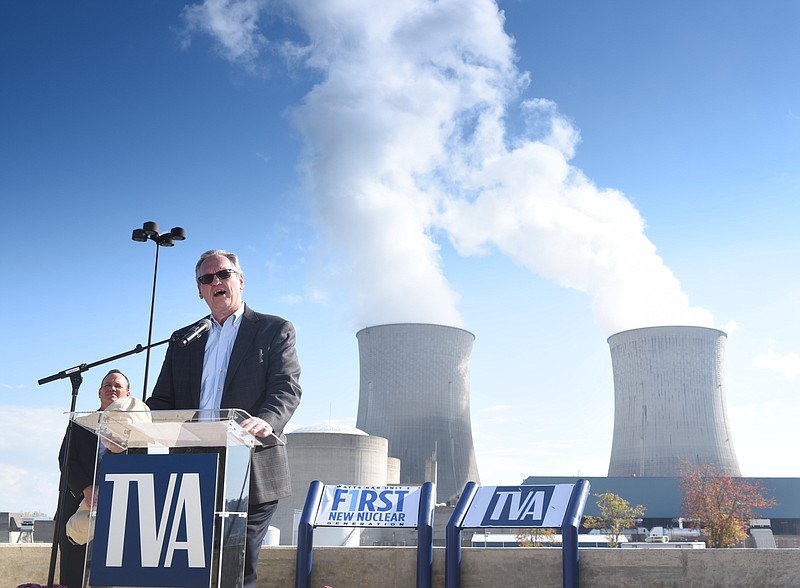The Tennessee Valley Authority recently made a financial decision it believed is in the best interests of its ratepayers. That's exactly what the government-owned but non-taxpayer-funded utility is supposed to do and what those it serves should expect it to do.
But the decision didn't please the green-energy-or-bust crowd.
Late last month, TVA decided not to buy the wind energy it had been window shopping for nearly six years. Its president, Bill Johnson, said the utility had enough power-generating capacity, the building it would have to do would cancel any savings the wind energy might bring, and it already was on the way to obtaining half its power from carbon-free sources.
He maintained the utility is "energy agnostic" and wants a diverse energy mix that is both reliable and low cost.
That's exactly what we believe TVA's and the country's energy plan should be - not anti-green energy but not anti-carbon energy, either. While technologies improve that would lower the price of wind and solar energy and their delivery systems, TVA and other utilities are and should be using what is available, what is efficient and what is reasonably priced for its ratepayers.
TVA and other utilities, for example, have replaced their older, less-efficient coal-fired plants with cleaner natural gas plants, added scrubbers and other cleaning machinery to its current coal plants, and increased nuclear capacity.
A TVA spokesman said last July the utility already had reduced its carbon output by 34 percent and had a target of reducing it by 60 percent in 2020. Coal, the spokesman said, once accounted for 60 percent of TVA's energy production but now was in the mid-20s. By 2020, he said, it was expected to drop into the teens.
Johnson also cited the uncertain nature of wind power in the decision not to further pursue an interconnection agreement with Houston-based Clean Line Energy Partners that would have brought the energy along 700 miles of lines from Texas and Oklahoma to Memphis, where TVA would have distributed it across the Southeast along the nation's biggest transmission system.
TVA officials, in addition, said long-term agreements presently don't make sense for the utility, which is expecting power demand will be "flat, or declining slightly."
"With the uncertainty of load," said Chief Financial Officer John Thomas, "the flexibility of having relatively short-term agreements for power is of great value to us right now."
That doesn't mean TVA won't ever look into securing more wind power, nor should it mean that. But taxpayer-funded credits for wind energy expire at the end of 2019, which will require the energy source to pay its own way. After that time, wind energy companies and utilities will know whether wind can be an efficient enough source to be included in an "agnostic's" list of power sources.
Between 2008 and 2015, wind energy credits cost taxpayers $9.6 billion, and they are expected to be on the tab for more than $23 billion from 2016 to 2020, according to the Congressional Research Service.
In the meantime, Clean Line Energy Partners officials said other Southeast utilities are interested in their wind power, but TVA was needed to be the home base of that energy in Memphis.
That, though, is not TVA's problem, but the wind energy company president, Michael Skelly, called it "not helpful." Nevertheless, he said the company would hold onto its permits and rights-of-way through Arkansas should TVA change its mind down the way.
Stephen Smith, executive director of Southern Alliance for Clean Energy in Knoxville, waxed hyperbolically about the utility's decision, saying it "killed what could have been one of the biggest and most important renewable energy projects in America" and that "we're becoming increasingly convinced that [Johnson] is anti renewable energy."
The decision means no such thing, as TVA's heavy push over the past decade to cleaner energy, more renewables and even to meeting the carbon-reduction targets of former President Barack Obama's Clean Power Plan - currently under review by the Trump administration - indicate.
"We have been following a path that is consistent with the direction of the Clean Power Plan," Johnson said in November 2016, "but we've been following it based on what's the best for our customers, and they happen to line up."
Indeed, the utility at that time, according to Smith's Southern Alliance organization, already had met 88 percent of the Clean Power Plan's requirements to reduce carbon emissions in the seven states where TVA operates.
"We really have been following the plan that says if we modernize the fleet as we diversify, what is the best economic and rate path to follow?" Johnson said. "And that's really what we will continue to do in every decision we make."
That's what it did in its recent wind power decision, and we hope that's what we can expect in the future.
